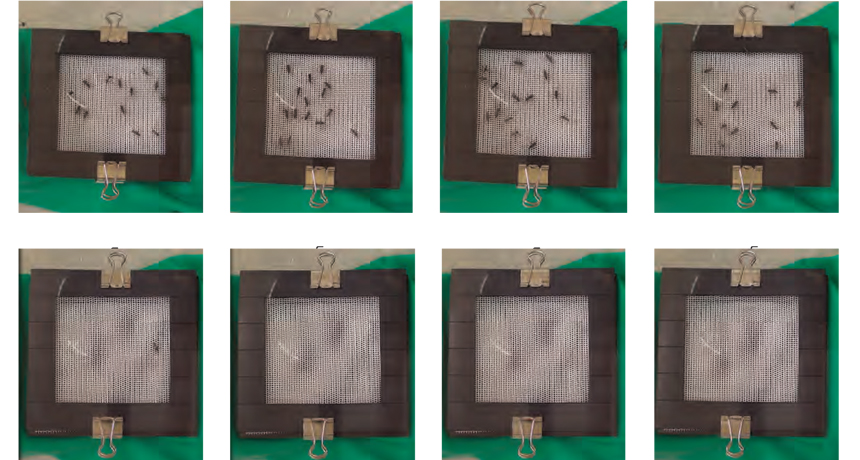Grape scents repel mosquitoes
New finding could lead to less toxic, less costly insect repellents

The bottom screens were treated with newfound chemicals that keep biting mosquitoes away. These new alternatives are less toxic and less expensive than DEET, the chemical currently used in many insect repellents.
P. Kain et al /Nature 2013
People have a love-hate relationship with DEET, the critical ingredient in many insect repellents. The chemical is great at repulsing biting pests like mosquitoes and fleas. But it’s also expensive — and may cause health problems in people. The good news: Scientists have just reported finding alternatives that are safer and less expensive.
The recently identified chemicals work as well as DEET. Three are even safe enough to use in food. And these repellents don’t smell like nasty chemicals: They smell like grapes. The scientists reported their discovery October 2 in Nature.
For many people, access to more affordable mosquito repellents is a life-or-death situation. Mosquitoes can carry a parasite that causes malaria. This deadly disease kills more than 500,000 people every year — mostly children, and mostly in poor African countries. DEET could help, but people in many malaria regions can’t afford it.
“Cost stops it from being used in the areas of the world where it is most needed,” said AnandasankarRay. An entomologist, or scientist who studies insects, Ray works at the University of California, Riverside.
Before they could find the new substitutes, Ray and his coworkers had to figure out how DEET works. People have been using it for 60 years, but no one knew how it repelled bugs. “It’s remained a mystery for so long,” Ray said.
His team solved that mystery with a study on fruit flies. (Fruit flies and mosquitoes are similar insects, but fruit flies are easier to work with.) First, the scientists changed some genes in the flies. Genes determine how a cell works. Ray’s team inserted genes that made the flies’ nerve cells glow when active.
Next the researchers exposed the altered flies to DEET. Some of the nerve cells in the flies’ antennae lit up, the scientists observed. Those cells contained a receptor called Ir40a. (Receptors are molecules that attach to some other molecule outside the cell and send a signal to that cell. In this case, Ir40a reacts to DEET molecules by sending a “get away!” signal to the cell.) That receptor holds the secret to DEET’s power: Without Ir40a, mosquitoes won’t scram.
The finding gives scientists “another set of tools” to find a better mosquito repellent, Mark Stopfer told Science News. A neuroscientist at the National Institutes of Health in Bethesda, Md., he did not work on the new study.
With DEET’s secret in hand, Ray and his coworkers searched for existing chemical compounds that would activate Ir40a in the same way. They considered only compounds that came from plants or animals or that already had been tested and found safe. The team’s search turned up three compounds that trigger Ir40a. They’re found in grapes, plums or orange flowers. Each also has been approved by the U.S. Food and Drug Administration for use in foods or cosmetics.
Ray says the compounds may ward off other insects, such as bedbugs and cockroaches. In fact, he plans to test that next.
POWER WORDS
entomology The scientific study of insects. One who does this is an entomologist.
gene A segment of DNA that codes, or holds instructions, for producing a protein. Offspring inherit genes from their parents. Genes influence how an organism looks and behaves.
malaria A disease caused by a parasite that invades the red blood cells. The parasite is transmitted by mosquitoes, largely in tropical and subtropical regions.
neuroscience Science that deals with the structure or function of the brain and other parts of the nervous system. Researchers in this field are known as neuroscientists.
parasite A creature that gets a benefit from another organism, called a host, but doesn’t provide it any benefits. Classic examples of parasites include ticks, fleas and tapeworms.
proteins Compounds made from one or more long chains of amino acids. Proteins are an essential part of all living organisms. They form the basis of living cells, muscle and tissues; they also do the work inside of cells. Among well-known, stand-alone proteins: the hemoglobin in blood and the antibodies that attempt to fight infections. Medicines frequently work by latching onto proteins.
receptor A molecule in cells that serves as a docking station for another molecule. That second molecule can turn on some special activity by the cell.







